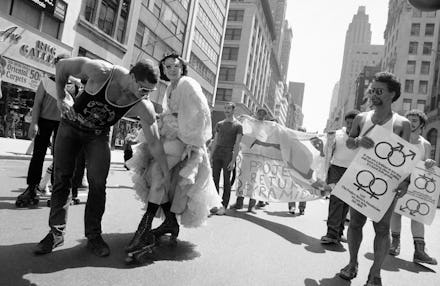20 Moments in LGBT History That You May Have Missed

Though the modern LGBT movement began with the Stonewall Riots of 1969, its victories grew exponentially in 2013. In just over 12 months, the number of states that legalize same-sex marriage doubled from nine to 18. The federal government now recognizes same-sex marriage as the Supreme Court struck down the Defense of Marriage Act this summer. This year was also full of symbolic triumphs. For the first time in history, for instance, a U.S. president invoked LGBT rights in his inaugural address.
The year 2013 will undoubtedly be among the most consequential for the LGBT community, alongside landmarks such as the assassination of Harvey Milk, the AIDS crisis, Don't Ask Don't Tell, DOMA, Lawrence v. Texas, and Massachusetts becoming the first state to legalize same-sex marriage.
As we celebrate lucky number '13, here is a list of lesser-known milestones that demonstrate the LGBT community's progress in such a short span of time.
1. Society for Human Rights (1924)
A German immigrant named Henry Gerber founds the U.S.' first gay rights organization in Chicago: the Society for Human Rights. Its mission is to increase visibility and understanding of gay issues through lectures and publications. Authorities, unfortunately, quickly disbanded it through arrests and political pressure.
2. Dropping the "H" bomb (1926)
The New York Times printed the word "homosexuality," becoming the first major news publication to do so.
3. "I just went GAY all of the sudden" (1938)
Cary Grant used the word "gay" in the film Bringing Up Baby to describe a feathery woman's bathrobe he decided to wear. It is considered the first time the word was used in reference to homosexuality in film.
4. It's all a spectrum (1948)
Alfred Kinsey publishes Sexual Behavior in the Human Male, in which he boldly claims that some 40% of men have had a least one sexual encounter with another man during their lifetime — though only one-tenth of those surveyed reported being exclusively homosexual. Five years later, he asserted that only 13% of women have had a same-sex encounter, and 2-6% of the women surveyed reported being exclusively homosexual.
5. Handing out pink slips (1950s)
The McCarthy-era purge of the federal government targetted gay employees. Known as the "lavender scare," inquiries led to the firing of thousands of military and federal workers. The gay ban became official in 1953 with an executive order signed by Dwight Eisenhower.
6. Christine comes home (1952)
Christine Jorgensen became a celebrity in the U.S. after undergoing the first widely publicized medical transition in Europe. Seven years later, authorities in New York refused to acknowledge her true gender by denying her a marriage license when she tried to wed her male fiancé.
7. "A sociopathic personality disturbance" (1952)
The American Psychiatric Association listed homosexuality as a "sociopathic personality disturbance" in its first manual of mental disorders.
8. The Daughters of Bilitis (1955)
Started as a social society, the Daughters of Bilitis expanded to become the first national lesbian organization in the country.
9. A Supreme victory (1958)
The Supreme Court ruled in favor of the LGBT community for the first time, asserting that a publication called One: The Homosexual Magazine falls under the protections of the First Amendment after the U.S. Postal Service declared it to be obscene material and refused to mail it.
10. Lovin' in the Land of Lincoln (1962)
Illinois became the first state to decriminalize sodomy between consenting adults.
11. "Screaming queens" (1966)
Compton's Cafeteria in San Francisco, a popular hangout for trans patrons, experienced riots when a police officer tried to arbitrarily arrest a trans woman and she threw hot coffee in his face. The outbreak and subsequent protests lead to the creation of a pioneering organization called the National Transsexual Counseling Unit.
12. Minnesota nice (1970)
Jack Baker and James Michael McConnell were denied a marriage license in Minnesota and appealed the decision all the way to the Supreme Court. Though the Court dismissed the case, the two went ahead and married anyway in 1971. They are still together.
13. The APA takes it back (1973)
After two decades of calling gay people crazy, the American Psychiatric Association no longer considered homosexuality a mental disorder.
14. First elected officials (1974)
Kathy Kozachenko won a seat on the Ann Arbor City Council and became the first openly gay person to hold public office — a title often wrongly attributed to Harvey Milk or Elaine Noble of Massachusetts. The same year, a Minnesota state senator named Allan Spear came out, becoming the first openly gay man in elected office.
15. Go Badgers! (1982)
Wisconsin became the first state to pass an anti-discrimination law that included sexual orientation.
16. Reagan breaks his silence (1987)
Ronald Reagan publicly addressed the AIDS crisis for the first time, more than six years into both his administration and the epidemic. At this point, over 20,000 people had died from AIDS, including the president's personal friend, Rock Hudson.
17. Tragedy in Nebraska (1993)
Trans man Brandon Teena is raped and murdered in Nebraska. His story serves as the basis for the movie Boys Don't Cry staring Hilary Swank.
18. Progress in the Nutmeg State (1997)
Evelyn Mantilla became the first openly bisexual state official after winning a race for Connecticut state representative.
19. You GO Kim Coco! (2006)
Kim Coco Iwamoto was elected to Hawaii's Board of Education, becoming the first openly-trans person to win a state-wide election.
20. A long time coming (2012)
Nearly 40 years after declassifying homosexuality as a mental illness, the American Psychiatric Association ceased to refer to transgender people as "disordered."